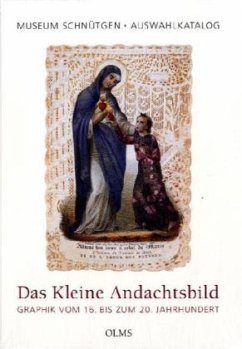"Ce petit ouvrage est avant tout exemplaire d'une volonté de partage de connaissances, d'un apprentissage à la fois pratique et scientifique et d'une association idéale de ce qui caractérise le travail de l'historien de l'art, qu'il soit universitaire ou conservateur." (France Nerlich, Revue de l'art, no 152/2006-2)Das Museum Schnütgen gehört mit seinem reichen Bestand an Skulpturen, Glasmalereien, Textilien, Goldschmiedewerken und Elfenbeinarbeiten zu den bedeutendsten Sammlungen mittelalterlicher Kunst in Europa. Bislang weitgehend unbekannt sind hingegen die rund 2600 graphischen Blätter, die Anfang der 1990er Jahre aus einer Kölner Privatsammlung in den Besitz des Museums gelangten. Es handelt sich um sogenannte Kleine Andachtsbilder aus der Zeit vom 16. bis zum 20. Jahrhundert. Besonders im Kontext der Volksfrömmigkeit spielten diese kleinformatigen Graphiken eine wichtige Rolle und sind teilweise heute noch in Gebrauch. Die Bildthemen der Blätter sind äußerst vielfältig undbieten einen breiten Querschnitt durch die christliche Ikonographie. So sollten sie vor jähem Tod, vor Krankheit und Zauberei bewahren, Reisende schützen, ins Neue Jahr geleiten, und besonders dienten sie bei Andacht und Gebet als Mittel der Versenkung, Erbauung und Ermahnung. Anhand von rund fünfzig Beispielen wird in dem vorliegenden Katalog erstmals ein repräsentativer Überblick dieses Sammlungsbestandes des Museums Schnütgen vorgestellt. The Schnütgen Museum, with its rich collections of sculpture, painted glass, textiles, and works in gold and ivory is one of Europe's most important collections of mediaeval art. Less well known until now have been some 2600 graphic works acquired in the early 1990s from a private collection in Cologne. This is a collection of small devotional pictures dating from the 16th to the 20th centuries. These small images played a particularly important role in popular religious observance, and are still sometimes used today. The themes of the pictures are incredibly varied and present a broad cross-section of Christian iconography. They were meant to ward off sudden death, illness or magic, to protect travellers, to see the new year in safely. Above all they were used in devotions and prayer as an aid to contemplation, and a means of edification and exhortation. On the basis of some fifty examples this catalogue offers the first representative overview of this area of the Schnütgen Museum's collections.
Bitte wählen Sie Ihr Anliegen aus.
Rechnungen
Retourenschein anfordern
Bestellstatus
Storno

